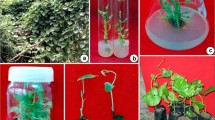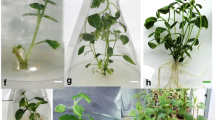Abstract
Efficient micropropagation, callus culture and root culture protocols were developed for the medicinal plant Phyllanthus urinaria(Euphorbiaceae) using single node explants. Maximum multiplication (16–20 shoots per explant) was achieved on Murashige and Skoog media supplemented with 5.0 μM kinetin. Murashige and Skoog and Anderson Rhododendron media promoted significant shoot culture growth in terms of numbers of shoots and nodes produced per explant. Rooting was achieved with 93–100% of the microshoots on Murashige and Skoog medium without growth regulators, although 1.25–5.0 μM α-naphthaleneacetic acid significantly increased the number of roots per explant. Regenerated plants were successfully acclimatized and 91% of plantlets survived under ex vitro conditions. Flowering was observed on micropropagated plants after 3–4 weeks of acclimatization. High frequency callus initiation and growth was achieved when single node explants were inoculated in the horizontal position on Murashige and Skoog medium supplemented with 5.0 μM indole-3-butyric acid. Other auxins such as 2,4-dichlorophenoxyacetic acid and α-naphthaleneacetic acid promoted moderate callus fresh weight increase, when used separately. Root cultures were successfully established on Murashige and Skoog medium containing 1.1 μM α-naphthaleneacetic acid. The optimized micropropagation, callus culture and root culture protocols offer the possibility to use cell/root culture techniques for vegetative propagation and secondary metabolism studies.
Similar content being viewed by others
References
Anderson WC (1978) Tissue culture propagation of Rhododendrons. In vitro 14: 334
Calixto JB, Santos ARS, Cechinel Filho V & Yunes RA (1998) A review of the plants of the genus Phyllanthus: Their chemistry, pharmacology and therapeutic potential. Med. Res. Rev. 18: 225–258
Catapan E (1999) In vitro culture and phytochemical analysis of Phyllanthus spp. MSc. Thesis, Federal University of Santa Catarina, Florianopolis, SC, Brazil (in Brazilian Portuguese with English summary)
Catapan E, Otuki MF, Viana AM, Yunes RA, Bresciani LFV, Santos ARS, Calixto JB & Cechinel-Filho V (2000a) Pharmacological activity and chemical composition of callus culture extracts from selected species of Phyllanthus. Die Pharmazie 55(12): 1–2
Catapan E, Otuki MF & Viana AM (2000 b) In vitro culture of Phyllanthus caroliniensis (Euphorbiaceae). Plant Cell Tiss. Org. Cult. 62: 195–202
Catapan E, Otuki MF & Viana AM (2001) In vitro culture of Phyllanthus stipulatus (Euphorbiaceae). Rev. bras. Bot. 24: 1–8
Gamborg OL & Eveleigh DE (1968) Culture methods and detection of glucanases in suspension cultures of wheat and barley. Can. J. Biochem. 46: 417–421
Kao KN & Michayluk MR (1975) Nutritional requirements for growth of Vicia hajastana cells and protoplasts at a very low population density in liquid media. Planta 126: 105–110
Khana P & Staba EJ (1968) Antimicrobials from plant tissue cultures. Lloydia 31: 180–189
Lloyd G & McCown B (1981) Commercially feasible micropropagation of mountain laurel, Kalmia latifolia, by use of shoot tip culture. Intl. Plant Prop. Soc. Proc. 30: 421–427
Liu KCSC, Lin MT, Lee SS, Chiou JF, Ren S & Lien EJ (1999) Antiviral tannins from two Phyllanthus species. Planta Med. 65: 43-46.
Murashige T & Skoog F (1962) A revised medium for rapid growth and bioassays with tobacco tissue cultures. Physiol. Plant. 15: 473–497
Santos ARS, Cechinel Filho V, Viana AM, Moreno FN, Campos MM, Yunes RA & Calixto JB (1994) Analgesic effects of callus culture extracts from selected species of Phyllanthus in mice. J. Pharm. Pharmacol. 46: 755–759
Santos ARS, Cechinel-Filho V, Yunes RA & Calixto JB (1995) Further studies on the antinociceptive action of hydroalcoholic extracts from plants of the genus Phyllanthus.J.Pharm.Pharmacol. 47: 66–71
Saradhi PP & Islamia JM (1997) Phyllanthus fraternus -A plant with anti-hepatitis viral activity. Ind. Crops Prod. 6: 35–40
Schenk RU & Hildebrandt AC (1972) Medium and techniques for induction and growth of monocotyledonous and dicotyledonous plant cell cultures. Can. J. Bot. 50: 199–204
Unander DW (1991) Callus induction in Phyllanthus species and inhibition of viral DNA polymerase and reverse transcriptase by callus extracts. Plant Cell Rep. 10: 461–466
Unander DW (1996) Phyllanthus species: in vitro culture and production of secondary metabolites. In: Bajaj YPS (ed) Biotechnology in Agriculture and Forestry, Vol 37, (pp 304–318). Springer-Verlag, Berlin
Unander DW, Bryan HH, Lance CJ & McMillan RT (1995) Factors affecting germination and stand establishment of Phyllanthus amarus (Euphorbiaceae). Econ. Bot. 49: 49–55
Unander DW(1998) Phyllanthus as a chemopreventive: a case study of why it is hard to translate ethnobotany to the clinic. Cancer Prevention International 3: 143–152
Webster GL (1957) A monographic study of the West Indian species of Phyllanthus. J. Amold Arb. 38: 51–373
White PR (1963) The Cultivation of Animal and Plant Cells, 2nd edn (pp 57–63). Ronald Press, New York
Author information
Authors and Affiliations
Corresponding author
Rights and permissions
About this article
Cite this article
Catapan, E., Luís, M., Silva, B.d. et al. Micropropagation, callus and root culture of Phyllanthus urinaria (Euphorbiaceae). Plant Cell, Tissue and Organ Culture 70, 301–309 (2002). https://doi.org/10.1023/A:1016529110605
Issue Date:
DOI: https://doi.org/10.1023/A:1016529110605




